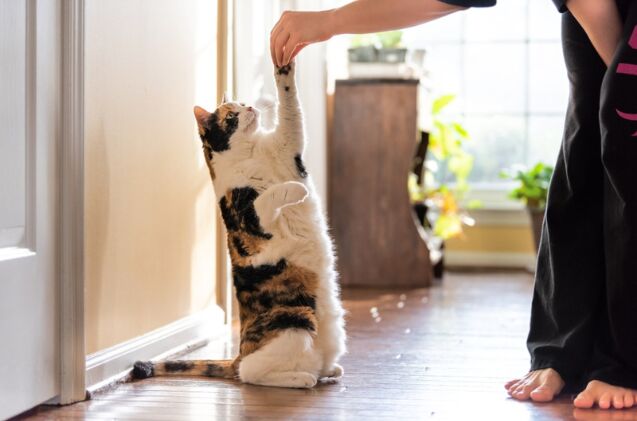Can I Teach A Cat Tricks?

Cats are often stereotyped as being aloof and independent. But beneath that mysterious exterior lies an intelligent and curious being capable of great things – you just have to learn how to tap into it!
Whether you’re interested in trick training your cat as a form of mental enrichment or strengthening your bond and creating lasting memories, we have you covered. In this blog post, we will explore the world of cat trick training. This includes debunking common myths, breaking down the process of training a cat, and sharing a list of fun tricks to help you get started.
Is it Possible to Train a Cat?
Yes! Your cat is just as capable of learning how to perform tricks as your dog. However, there are some differences in how you approach this process.
Dogs are often motivated by their bond with their handler and the praise they will receive for performing as expected. This is far less likely to work for your cat. Instead, you will need to find the right inspiration. For many, this comes in the form of high-value treats like diced chicken, sardines, or low-sodium tuna. The smellier the treat, the better.
With the right motivator and a lot of patience, your cat can learn a wide variety of fun tricks and useful skills.
How Long Does It Take to Teach a Cat a Trick?
The time required for a cat to learn a trick will depend on many factors, including the difficulty of the trick, the cat’s eagerness to learn, and the way you approach the training session. We have two cats in our house, and they fall at very different ends of the spectrum. Pippen is highly trainable and quickly picks up tricks, while Jinx is much more stubborn and takes longer to come around.
Several of these factors can be influenced by you directly. Have you found the right motivator for your cat? Are you experimenting with different training approaches to find the one that works best? Are you trying to move through the training process too quickly?
However, some factors are beyond your control. If your cat is uninterested in training, even your best efforts to motivate them may fall short.
Is it Too Late to Teach My Cat Tricks?
There is an old myth that states: “You can’t teach an old dog new tricks.” This has been proven to be false by many trainers, with dogs even in their senior years. But what about cats? Is there an expiry date on when your cat can be taught to perform tricks?
The best time to start training a cat is when they are young, but that doesn’t mean it’s the only time! Your older cat may be slower to learn or a little more reluctant to get started, but with a little patience and the right motivation, you can train cats of all ages.
7 Fun Tricks to Teach Your Cat
Now that we’ve established that cats CAN be trained, you may be wondering – what tricks can a cat learn to perform? Like training a dog, it is recommended that you start with simple tricks and obedience lessons. For example, you could teach your cat to come to their name or sit. However, as they master the basics, you can experiment with more elaborate and entertaining tricks.
Here are a few simple tricks to help you get started:
Come
One of the most basic tricks you can teach your cat is to come when called. This could mean coming to their name, a command like “come,” or responding to a whistle. This is a great skill that can be very helpful. Have you ever lost your cat in the house, only to have them emerge hours later from their hiding place? Being able to call your cat will save you from all the stress and anxiety you face during that time!
First, grab your cat’s favorite bag of treats or place some in a container. Shake the treats while calling out your verbal command or your cat’s name. When they come to you, mark the behavior with a “Yes!” acknowledgment (or a clicker) and give them their reward.
When your cat is coming reliably to this, you can start to phase out the treats. Give your verbal command, then wait a few seconds before shaking the treats—Mark and reward when your cat comes to you. Slowly lengthen the time between the verbal command and the treat shake, emphasizing coming to the sound of the command. Eventually, your cat will respond and come to you without any added sound or motivation.
You can phase out the treats entirely by rewarding them every other time, then every third time.
Sit
Another obedience basic that most dogs learn is to sit. So, why not teach this to your cat too? Begin by watching for your cat to sit naturally before giving the command, marking the behavior, and offering a reward. Alternatively, you can hold the treat above their head and move it slightly towards their back, luring them into the correct position.
When your cat shows they can sit on command reliably, start phasing out the treats while still marking the behavior to communicate that they are correctly doing what they have been asked.
Stay
Now that your cat can sit on command, try introducing the idea of “Stay.” To begin, decide whether you want to use a verbal command alone or use a hand gesture like holding your hand up like a stop sign. The most important thing to remember is to be consistent.
Give the command and wait a couple of seconds. If they remain seated, mark the behavior and reward them with a treat. If not, don’t worry! Simply place them in a sit and try again.
Slowly increase the length of time between giving the command and the reward, challenging your cat to hold the stay longer without getting up or moving. You can then introduce distance by taking a short step backward, then two, and so forth. This allows for many variations of difficulty, making a command you can continue to build upon for a long time.
Speak or Sing
A simple trick that will amuse friends and family at every gathering, try teaching your cat to vocalize when told to “Speak” or “Sing.” Your choice of command may vary depending on the sound your cat makes. This is especially easy to teach if your cat is naturally talkative.
Hold up a treat or your cat’s favorite toy. When your cat meows to tell you they want it, give the command, then reward them. Over time, they will learn that responding when you give the command will lead to a treat.
Spin
A cute trick that is surprisingly easy to train is to spin around in a circle. Take one of your cat’s favorite treats and use it to lure them around in a circular motion. Don’t give them the treat until they have completed the circle. When you notice they follow the treat without hesitation, try giving the command first, then luring them around.
Practice until you notice that your cat is starting to move through the motions without the need for the lure. You can then begin phasing the treat out as a lure, reserving it to use solely as a reward.
Jump Through a Hoop
We’ve all seen the adorable image of a tiger or lion jumping through a hoop at the circus or a dog jumping through a hoop as part of an agility competition. But have you ever considered teaching your cat to perform this same trick?
Hold your hoop close enough to the ground that your cat can simply walk through it. Holding a treat on the opposite side from your cat, lure them through, giving them the treat when they have moved through it successfully. Select a verbal command, like “Jump” or “Hoop.” Give the command before offering the treat as a lure to make the connection between the command and the desired action.
Phase out the lure by giving the command and waiting a few seconds before offering the treat. Each time, wait a little longer before giving them the treat. The lure is no longer needed when your cat responds by moving through the hoop before the treat is offered.
The next step is to slowly begin lifting the hoop higher. Hold it just high enough that your cat must do a slight hop to get up and through, rewarding them when they complete the trick. Start moving it up a little higher each time you see they are comfortable until you are happy with the height they must jump to travel through the hoop. But be realistic – you don’t want to move high enough that you are setting your cat up to fail or risk an injury!
Guess the Hand
Another fun and adorable trick, this involves holding both hands out, closed in fists, and your cat guessing where the treat is by touching the hand that holds it.
First, you must define what “guessing” looks like for your cat. This could be pawing at the hand with the treat or touching the hand with their nose. If you aren’t sure which will be easier for your cat, you may wish to start the first training session with an open mind and let their natural reaction set the tone for this.
Hold both hands out, palm up, with a treat in one. When your cat reaches out to paw at the hand or nose at it, depending on your desired action, mark it with a “Yes!” or a click before giving them the treat. Repeat this process until they perform the action reliably without hesitation.
Transition to a closed hand by holding it open for a couple of seconds so your cat can see the treat, then closing it (still palm up) and allowing your cat to choose. When that is comfortable, try closing your hand and turning it over before holding your hands out to your cat.
Tips for Training a Cat
Are you ready to start your trick training journey? Here are a few tips and tricks to help you begin on the right foot (or paw).
Discover Your Cat’s Best Motivation
The best form of motivation will differ from one cat to the next. Our cat Pippen would do just about anything for a small piece of chicken, while our other cat Jinx needs something with a stronger smell, like tuna.
If you’re unsure what your cat would prefer, try placing several options on a tray and setting it on the floor. What does your cat gravitate to first?
Keep it Positive
Cats respond best to positive motivation, not punishment. Getting frustrated or lashing out at your cat isn’t going to accomplish anything. Instead, it will simply cause them to lose any interest they may have in learning. Focus on rewarding and praising them, making this a positive experience.
Stick to Short Training Sessions
Long, drawn-out sessions can become frustrating for both you and your cat, especially if they are new to training. Instead, break everything down into short sessions of 10 – 15 minutes at a time. Pay attention to your cat’s attention span, and don’t be afraid to end a session early if either of you isn’t “feeling it.” You can always pick it up where you left off tomorrow.
Try Clicker Training
One of the most important things to consider when training your cat is effectively communicating what you are asking for. Clicker training refers to using a tool that makes a “click” sound when pressed, making it easy to identify the moment your cat performs the behavior you want to see. This can be paired with other tools, like a target stick, as seen in the Cat School Clicker Training Kit.
Final Thoughts – Trick Training and Cats
If you want to train your cat to perform tricks, I have good news – it can be done! However, you will need to set expectations and approach training in a way that connects with them. This includes finding the best motivator (hint: try a smelly treat), allowing your cat to set the pace of your training sessions, and focusing on training with positive motivation.
Trick training your cat is a great way to challenge their mind and strengthen your bond.

Britt Kascjak is a proud pet mom, sharing her heart (and her home) with her “pack” which includes her husband John, their 2 dogs – Indiana and Lucifer – and their 2 cats – Pippen and Jinx. She has been active in the animal rescue community for over 15 years, volunteering, fostering and advocating for organizations across Canada and the US. In her free time, she enjoys traveling around the country camping, hiking, and canoeing with her pets.
More by Britt
























